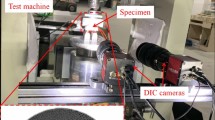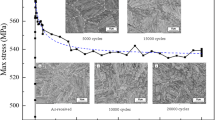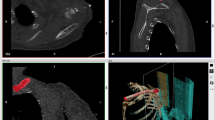Abstract
RECENT papers by Porter and Levy1 and Benham and Ford2 have suggested that the conventional S/N curve is composed of two separate curves, a discontinuity occurring at some particular stress-level. The former authors concluded from a large number of rotating bending tests on copper that the discontinuity occurred at about ± 21,500 lb./sq. in.; for lower stresses fatigue cracks originating in slip bands; for higher stresses cracks developing from L-shaped nuclei. Kemsley3 also found that with copper specimens tested at ± 15,000 lb./sq. in. (giving fracture after long endurances) cracks formed in slip bands and were transcrystalline, while at ± 25,000 lb./sq. in. (giving fracture with low endurances) slip bands were virtually absent from the specimen and cracks appeared to be inter crystalline. Benham and Ford2, who tested mild steel in direct stress, found for large stress amplitudes that the specimen gauge-length extended permanently each cycle and a ‘necked-out’ fracture resulted. They termed this phenomenon ‘cyclic creep’ and such failures occurred while the stresses corresponded to the upper portion of the composite S/N diagram. For stresses in the lower portion of the S/N diagram typical fatigue fractures occurred and they suggested that, if the fatigue mechanism could be suppressed as the cyclic stress decreased, the upper curve might flatten out to a ‘cyclic creep limit’.
This is a preview of subscription content, access via your institution
Access options
Subscribe to this journal
Receive 51 print issues and online access
$199.00 per year
only $3.90 per issue
Buy this article
- Purchase on SpringerLink
- Instant access to full article PDF
Prices may be subject to local taxes which are calculated during checkout
Similar content being viewed by others
References
Porter, J., and Levy, L. C., J. Inst. Metals, 89, 86 (1960).
Benham, P. P., and Ford, H., J. Mech. Eng. Sci., 3, 119 (1961).
Kemsley, D. S., J. Inst. Metals, 85, 417 (1957).
Coffin, L. F., Internal Stresses and Fatigue of Metals, 353 (Elsevier, 1959).
Hempel, M., Int. Conf. Fatigue, Inst. Mech. Eng., 543 (1956).
Wadsworth, N. J., Phil. Mag., 6, 397 (1961).
Wood, W. A., Phil. Mag., 3, 692 (1958).
May, A. N., Nature, 185, 303 (1960).
Holden, J., Phil. Mag., 6, 547 (1961).
Forsyth, P. J. E., Int. Conf. Fatigue, Inst. Mech. Eng., 535 (1956).
Jacquet, P. A., Int. Conf. Fatigue, Inst. Mech. Eng., 506 (1956).
Frost, N. E., J. Mech. Phys. Solids, 9, 143 (1961).
Author information
Authors and Affiliations
Rights and permissions
About this article
Cite this article
FROST, N. Difference between High- and Low-Stress Fatigue. Nature 192, 446–447 (1961). https://doi.org/10.1038/192446b0
Issue date:
DOI: https://doi.org/10.1038/192446b0
This article is cited by
-
Factors Affecting the Fatigue Behavior of Fiber-Reinforced Polymer Matrix Composites
Journal of The Institution of Engineers (India): Series C (2023)
-
Significance of the Discontinuity in S/N Fatigue Curves
Nature (1964)



